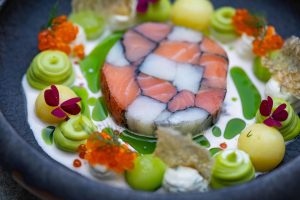Filipino Dessert Dominance: Ube and Buko Pie Reinvent Pastry Arts
If you ask anyone to name a popular Filipino dessert, chances are they’ll say “ube” or “buko pie”. These two sweet treats have taken the world by storm, dominating the pastry scene with their vibrant colors and unique flavors. But what exactly is it about ube and buko pie that makes them so special? In this article, we’ll delve into the history and cultural significance of these desserts, as well as their impact on the world’s pastry arts scene. Get ready to discover the delicious dominance of ube and buko pie in Filipino desserts!
A Brief History of Ube and Buko
Ube, also known as purple yam, is a tuberous root vegetable that is native to the Philippines. It has a distinct bright purple color and a sweet, nutty flavor. Ube has been used in Filipino cuisine for centuries, particularly in desserts. It is often boiled, mashed, and mixed with condensed milk and coconut milk to make a creamy and indulgent dessert.
On the other hand, buko pie is a relatively newer addition to the Filipino pastry scene. It originated in the province of Laguna, known for its abundance of coconut trees. The pie is made with young coconut meat, mixed with condensed milk and topped with a creamy custard filling, and encased in a flaky crust. Its popularity quickly spread throughout the country and it has become a staple in every Filipino celebration.
Cultural Significance
In the Philippines, food is a big part of their culture and identity. Ube and buko pie are no exception – they both hold significant cultural meanings and are deeply embedded in Filipino traditions. For instance, ube is often associated with celebrations and special occasions such as birthdays and fiestas. Its vibrant purple color is also considered lucky and represents royalty and wealth in Filipino culture.
Meanwhile, buko pie is often served during Christmas and New Year’s celebrations in the Philippines. This is because coconut trees are known to bear fruit all year round, symbolizing prosperity and abundance. The pie itself is also often gifted to family and friends during Christmas, as a token of love and appreciation.
Impact on the Pastry Arts Scene
With the rise of social media and diverse food trends, Filipino desserts have gained international recognition in recent years. Ube and buko pie, in particular, have made their mark in the global pastry arts scene, reinventing traditional flavors and giving them a modern twist.
In the United States, ube has become a popular flavor for ice cream, cakes, and even doughnuts. It has also been featured in high-end restaurants and bakeries, with chefs experimenting with unique ways to showcase the purple yam in their dishes. As for buko pie, it has been hailed as a must-try dessert in various travel and food blogs, with some even dubbing it as the “ultimate Filipino comfort food”.
Besides gaining popularity, the rise of ube and buko pie has also shone a spotlight on other Filipino desserts, elevating the country’s pastry scene as a whole. This has opened doors for more Filipino chefs and bakers to showcase their skills and creativity, not just with traditional desserts, but also with new and innovative recipes inspired by these classic favorites.
In Conclusion
It’s safe to say that ube and buko pie have truly reinvented the pastry arts scene, not just in the Philippines, but also in other parts of the world. These vibrant and delicious desserts have not only satisfied our sweet tooth but have also showcased the rich culture and heritage of Filipino cuisine. So if you ever come across ube or buko pie in your culinary adventures, be sure to give them a try and experience the dominance of Filipino desserts for yourself!











